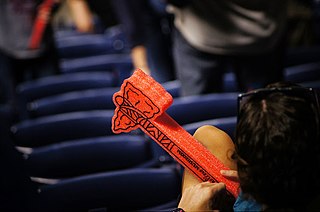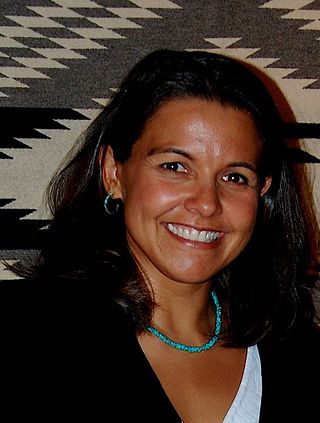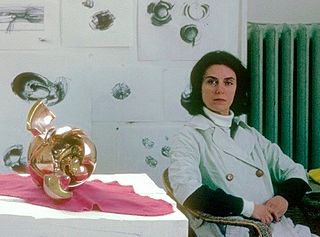
The Onondaga people are one of the five original nations of the Haudenosaunee (Iroquois) Confederacy in the Northeastern Woodlands. Their historical homelands are in and around present-day Onondaga County, New York, south of Lake Ontario.

Chief Illiniwek was the symbol of the University of Illinois Urbana-Champaign (UIUC), associated with the university's intercollegiate athletic programs, from October 30, 1926, to February 21, 2007. Chief Illiniwek was portrayed by a student to represent the Illiniwek, the state's namesake, although the regalia worn was from the Sioux. The student portraying Chief Illiniwek performed during halftime of Illinois football and basketball games, as well as during women's volleyball matches.
The Syracuse Orange are the athletic teams that represent Syracuse University. The school is a member of NCAA Division I and the Atlantic Coast Conference. Until 2013, Syracuse was a member of the Big East Conference.

The Upstate Medical University Arena is a multi-purpose arena located in Syracuse, New York. It is part of the Oncenter Complex. Designed by Edgarton and Edgarton and built from 1949 through 1951, the structure is significant as an example of a World War I, World War II and Aroostook War commemorative and as "an early and sophisticated example of single-span thin-shell concrete roof construction." It was listed on the National Register of Historic Places in 1988. The Upstate Medical University Arena has been renovated twice, in 1994 and 2018.

Moundville Archaeological Site, also known as the Moundville Archaeological Park, is a Mississippian culture archaeological site on the Black Warrior River in Hale County, near the modern city of Tuscaloosa, Alabama. Extensive archaeological investigation has shown that the site was the political and ceremonial center of a regionally organized Mississippian culture chiefdom polity between the 11th and 16th centuries. The archaeological park portion of the site is administered by the University of Alabama Museums and encompasses 185 acres (75 ha), consisting of 29 platform mounds around a rectangular plaza.
Oren R. Lyons Jr. is a Native American Faithkeeper of the Wolf Clan. The Seneca are one of the Six Nations of the historic Haudenosaunee Confederacy. For more than 14 years he has been a member of the Indigenous Peoples of the Human Rights Commission of the United Nations and has had other leadership roles.

Charlene Teters is a Native American artist, educator, and lecturer. Her paintings and art installations have been featured in over 21 major exhibitions, commissions, and collections. She is a member of the Spokane Tribe, and her Spokane name is Slum Tah. She was born and raised in Spokane, Washington, near the Spokane Indian Reservation.

Stereotypes of Indigenous peoples of Canada and the United States of America include many ethnic stereotypes found worldwide which include historical misrepresentations and the oversimplification of hundreds of Indigenous cultures. Negative stereotypes are associated with prejudice and discrimination that continue to affect the lives of Indigenous peoples.

Since the 1960s, the issue of Native American and First Nations names and images being used by sports teams as mascots has been the subject of increasing public controversy in the United States and Canada. This has been a period of rising Indigenous civil rights movements, and Native Americans and their supporters object to the use of images and names in a manner and context they consider derogatory. They have conducted numerous protests and tried to educate the public on this issue.

Otto the Orange is the mascot for the Syracuse Orange, the athletic teams of Syracuse University in Syracuse, New York, USA. Otto is an anthropomorphism of the color orange, wearing a large blue hat and blue pants. Otto can often be seen at Syracuse sporting events in the JMA Wireless Dome and other venues.

The Arizona State Museum (ASM), founded in 1893, was originally a repository for the collection and protection of archaeological resources. Today, however, ASM stores artifacts, exhibits them and provides education and research opportunities. It was formed by authority of the Arizona Territorial Legislature. The museum is operated by the University of Arizona, and is located on the university campus in Tucson.

Paul Apodaca is an associate professor of Anthropology and American Studies at Chapman University.
Lyle Thompson is a Haudenosaunee professional lacrosse player from the Hawk Clan of the Onondaga Confederacy of the Six Nations of the Grand River. His native name is 'Deyhahsanoondey', which translates into 'He's Flying Over Us'. He plays both indoor and outdoor professional lacrosse. In professional outdoor lacrosse, he plays at the attack position for the Cannons Lacrosse Club of the Premier Lacrosse League. In professional indoor lacrosse, he plays at the forward position for the Georgia Swarm of the National Lacrosse League. He also competes internationally in both indoor lacrosse for Haudenosaunee men's national indoor lacrosse team, and outdoor lacrosse for the Haudenosaunee men's national outdoor lacrosse team.
In 2005 the National Collegiate Athletic Association (NCAA) distributed a "self evaluation" to its member institutions for teams to examine the use of potentially offensive imagery with their mascot choice. This examination was done in accordance with NCAA policy that requires each member institution to maintain an "atmosphere of respect for and sensitivity to the dignity of every person." Fourteen schools either removed all references to Native American culture or were deemed not to have references to Native American culture as part of their athletics programs. Subsequently, 19 teams were cited as having potentially "hostile or abusive" names, mascots, or images, that would be banned from displaying them during post-season play, and prohibited from hosting tournaments.

Redface is the wearing of makeup to darken or redden skin tone, or feathers, warpaint, etc. by non-Natives to impersonate a Native American or Indigenous Canadian person, or to in some other way perpetuate stereotypes of Indigenous peoples of Canada and the United States. It is analogous to the wearing of Blackface. In the early twentieth century, it was often white performers, who wore blackface or redface when portraying Plains Indians in Hollywood Westerns. In the early days of television sitcoms, "non-Native sitcom characters donned headdresses, carried tomahawks, spoke broken English, played Squanto at Thanksgiving gatherings, received 'Indian' names, danced wildly, and exhibited other examples of representations of redface".

Stephanie Fryberg is a Tulalip psychologist who received her Master's and Doctorate degrees from Stanford University, where in 2011 she was inducted into the Multicultural Hall of Fame. In the same year, she testified before Senate on Stolen Identities: The impact of racist stereotypes on Indigenous people. She previously taught psychology at the University of Arizona, at the Tulalip Community at Marysville School, and at the University of Washington. She currently teaches American Indian Studies and Psychology at the Northwestern University in Chicago, and is a member of the Tulalip Tribes. Her research focuses on race, class, and culture in relation to ones psychological development and mental health. She translated Carol Dweck's growth mindset; taking a communal-oriented approach. The students on her tribe's reservation who received her translation had significant improvement compared to the original version.

Luise Clayborn Kaish was an American artist known for her work in sculpture, painting, and collage. Throughout her career, Kaish's work was exhibited and collected by major museums, including the Smithsonian Institution's National Museum of American Art, the Museum of Modern Art, the Whitney Museum, the Jewish Museum, and the Metropolitan Museum of Art. Kaish created monumental sculptures in bronze, aluminum, and stainless steel, which remain on view in educational, religious, and commercial settings across the United States and internationally.

The Chicago Blackhawks name and logo controversy refers to the controversy surrounding the name and logo of the Chicago Blackhawks, a National Hockey League (NHL) ice hockey team based in Chicago, Illinois. The use of terms and images referring to Native Americans/First Nations as the name or mascot for a sports team without permissions from or consultations with local Indigenous communities is a topic of public controversy in the United States and Canada. Since the 1960s, as part of the indigenous civil rights movements, there have been a number of protests and other actions by Native Americans and their supporters targeting the more prominent use of such names and images by professional franchises such as the Cleveland Guardians formerly known as the "Indians" of Major League Baseball (MLB) that was officially discontinued in 2016; the Washington Commanders formerly known as the "Redskins" of the National Football League (NFL), the NFL's Kansas City Chiefs and MLB's Atlanta Braves, the latter two attracting criticism of "the tomahawk chop" often performed by their fans. Like other teams with tribal mascots, there are calls from Indigenous activists and organizations to change the Blackhawks' name and logo and eliminate tribal mascots and imagery throughout sports. In contrast to generic names used by other teams, Blackhawks refers to a World War I-era U.S. Army division which was named for prominent Illinois-based Native American chief Black Hawk.













